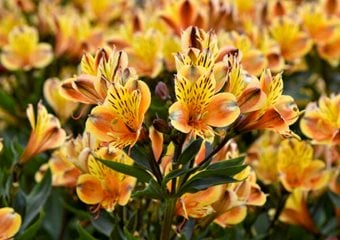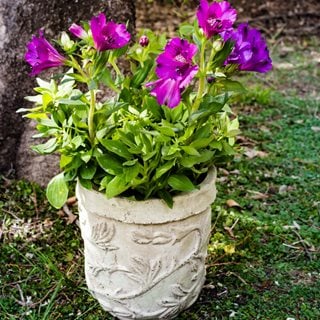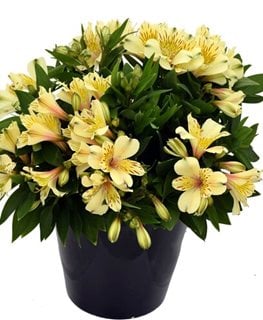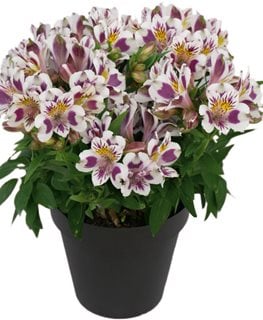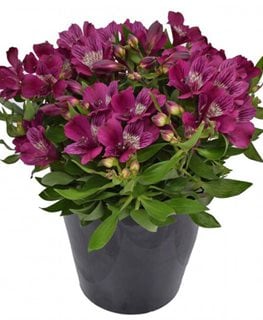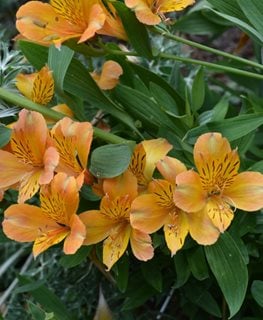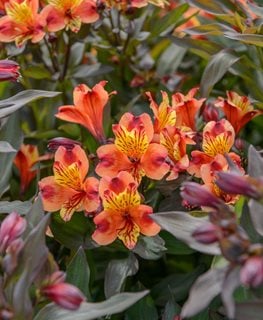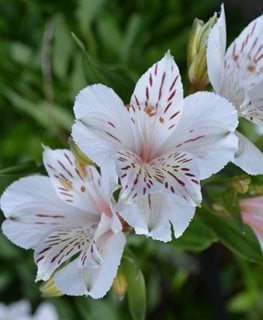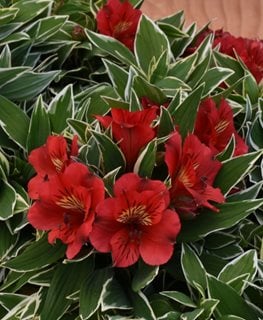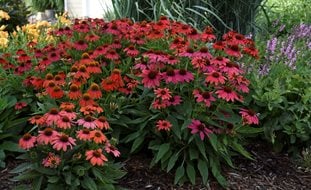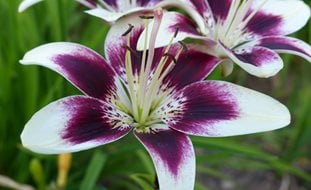How to Grow Beautiful Peruvian Lilies (Alstroemeria)
Learn how to plant, grow, and care for these prolific, long-lasting bloomersSometimes the best inspiration for choosing new flowers to grow in your garden is a visit to the local florist. One flower you’re sure to come across is Alstroemeria, also known as Peruvian lily.
Once grown primarily for commercial use as a cut flower, Alstroemeria has more recently become a popular addition to the perennial garden, where it puts on a dazzling display of flamboyant lily-like blooms, ranging in color from whisper-soft pastels to vibrant jewel tones.
In temperate climates, this South American native can be grown outdoors year-round, often blooming for months on end. But gardeners in cooler climates can also enjoy the exotic beauty of Peruvian lilies by growing them in a container that can be brought indoors over the winter months.
On this page: Basics | Planting | Care | Varieties | Frequently Asked Questions
- BASICS
- HOW TO PLANT ALSTROEMERIA
- ALSTROEMERIA PLANT CARE
- ALSTROEMERIA VARIETIES
- FREQUENTLY ASKED QUESTIONS
BASICS
Botanical name:
Alstroemeria spp. and hybrids
Common names:
Peruvian lily, lily of the Incas, princess lily, parrot lily
Plant type:
Tuberous-rooted herbaceous perennial
Zones:
Typically 8-10; some may be hardy to zone 6 or 7 when given extra protection.
Exposure:
Full sun to part shade
Height/spread:
Anywhere from 8 inches to 4 feet tall, depending on the variety. Dwarf forms (also called “micro Alstroemeria”) are generally under a foot tall.
Bloom time:
Blooms continuously from late spring until frost if spent flowers are removed promptly.
Foliage:
Lance-shaped leaves range in color from emerald green to bronze. Some cultivars have variegated foliage. Fun fact: The leaves actually grow upside down, twisting 180 degrees from the base as they unfurl—a process called “resupination.”
Flowers:
Trumpet-shaped blooms up to 2 inches across come in shades of orange, yellow, red, pink, purple, salmon, white, or bi-colored, often accented by darker whiskers or speckles. Each flower stem produces multiple blooms.
Special attributes:
- Attracts bees, butterflies, and hummingbirds
- Great for cutting, with a vase life of two weeks or longer
- Drought tolerant once established
- Will multiply in the garden over time
Landscape uses:
Mixed borders, cut flower gardens, container gardens, pollinator gardens, cottage gardens
PLANTING ALSTROEMERIA
When to plant:
In spring, after the danger of frost has passed.
Where to plant:
Alstroemeria prefer a sunny site with fertile, well-drained soil, although they will benefit from some afternoon shade where summers are exceptionally hot. Do not plant in an area prone to standing water, which can lead to root rot. If possible, plant taller types in a location sheltered from the wind to keep the stems from bending and breaking.
How to plant:
Alstroemeria grows from tuberous roots, which are easily damaged if not handled carefully. To avoid breakage, dig a hole about 6 to 8 inches deep, remove the plant from its nursery pot, and then nestle it into the hole so that the soil level is even with the top of the rootball. Avoid spreading or teasing out the roots, even if they look congested. Backfill with the surrounding soil, making sure the roots are completely covered, and then tamp down the soil gently. Water well after planting to settle the soil around the rootball, topping off with more soil if necessary.
Spacing:
Space plants about 1 to 2 feet apart, depending on their width at maturity.
Growing in containers:
Compact varieties of Peruvian lily are especially well-suited for growing in containers, either alone or in mixed arrangements. Choose a pot slightly wider and deeper than the plant’s root system, making sure there are plenty of drainage holes in the bottom to prevent the soil from getting waterlogged. Half fill the container with a high-quality all-purpose potting mix, and tuck the plant in so that the top of the rootball sits about an inch below the rim. Backfill with more potting mix, firming it down around the plant with your fingers to remove any air pockets. Get more tips for growing plants in containers.
ALSTROEMERIA CARE
Watering:
Alstroemeria thrives when given consistent moisture, but they will not tolerate soggy soil, which can lead to rotting of the fleshy, tuberous roots. During dry spells, provide about an inch of water per week. Water container-grown plants whenever the top inch of soil feels dry. Once plants are established, they can handle short periods of drought.
Amendments and fertilizer:
Because Alstroemeria grows best in fertile, well-draining soil, amend it at planting time with compost to improve drainage and add nutrients. Also apply a layer of mulch around the root zone of your plants to help keep the soil moist and insulate the roots from temperature extremes.
In spring, an application of a balanced, slow-release fertilizer designed for flowering plants will help jumpstart growth. To keep your potted Peruvian lilies in bloom, feed them monthly during the growing season using a water-soluble plant food.
Pruning and deadheading:
To enjoy a steady crop of flowers, remove spent blooms by gently pulling the whole stem up from the base rather than snipping them off. This encourages the growth of new stems and another flush of blooms. In spring, when fresh shoots form, tidy up your plants by pulling out old stems to make way for new growth.
Propagating:
The quickest and easiest way to propagate Alstroemeria is to divide mature clumps in early spring, making sure there are healthy tubers in each division. Alstroemeria can also be propagated from seed, but germination rates tend to be low and plants started from collected seeds may not stay true to the parent. *See note below on propagating or dividing patented plants (check your plant tags for the ® or ™ symbol by the plant name).
Overwintering:
In climates where Alstroemeria aren’t winter hardy, you can overwinter the tubers indoors by digging them up in the fall after the first frost, being careful not to damage the roots. With some soil still attached, pack the roots between layers of peat moss, sawdust, or wood shavings and store them in a cool place (between 35° to 45°F).
If growing plants in containers, bring the pots indoors over the winter and store in a cool garage or basement, watering just enough to keep the soil from completely drying out. You can move your Peruvian lilies outdoors again when the weather warms in the spring.
Pests and diseases:
Slugs and snails may attack the foliage, especially tender, young leaves. Also watch out for aphids, thrips and spider mites. In overly wet conditions, plants may be susceptible to botrytis (gray mold).
ALSTROEMERIA VARIETIES
FREQUENTLY ASKED QUESTIONS
Are Peruvian lilies perennials?
Yes, similar to dahlias, they are considered to be fleshy-rooted tuberous perennials, which means they grow from bulb-like tubers that produce new leafy stems every spring. In their growing zone, they will return year after year, but they will usually not survive in climates with winter temperatures below 10° to 15°F.
Is Peruvian lily toxic?
No. According to the ASPCA database of poisonous plants, Alstroemeria is not toxic to cats, dogs, or horses. However, sap from the plant can cause contact dermatitis, so wear gloves when handling if you have sensitive skin.
Are Peruvian lilies invasive?
Alstroemeria has a tendency to spread and colonize under favorable growing conditions, but it hasn’t been classified as being invasive in North America. If spreading is a concern, grow your Peruvian lilies in a container or where they won’t encroach upon nearby plants.
In what month do Peruvian lilies bloom?
Alstroemeria plants will usually bloom continuously from late spring through fall and throughout most of the year in frost-free climates. During the hottest months of the summer, flowering may slow down or stop but should resume once the cooler weather of fall arrives.
Are Peruvian lilies related to true lilies?
Although the flowers look very similar, Peruvian lilies are not actually a member of the lily family (Liliaceae) and instead belong to the Alstoemeriaceae. Unlike true lilies, which have short bloom periods, Peruvian lilies will bloom for months.
Do Peruvian lilies require staking?
Taller varieties will often benefit from staking because the stems have a tendency to flop when laden with flowers. If you plant bushier dwarf varieties, staking is rarely necessary.
How do you harvest Peruvian lilies for cut flowers?
Although they have no fragrance, Peruvian lilies are fantastic cut flowers because of their long vase life. To enjoy their beauty as long as possible, harvest the flower clusters when they have one or two blooms open and the other buds are showing color. Instead of cutting the flower stems, it’s best to pluck them from the ground by grasping each stem near the base and pulling upward with a gentle tug. Before you place the stems in water, snip off the white part of each stem (the underground portion) and then trim the stem to the desired length. Also remove any foliage that might sit below the water line.
*REGARDING PROPAGATION: When it comes to propagating patented plants, there are strict rules in place prohibiting reproduction or propagation of these plants in any way. This means you can't reproduce them (even for use in your own garden), sell them, or bring them into the country without permission. The law does not make exceptions for what some might consider minor infringements. Any unauthorized use of patented plants is considered an infringement.
